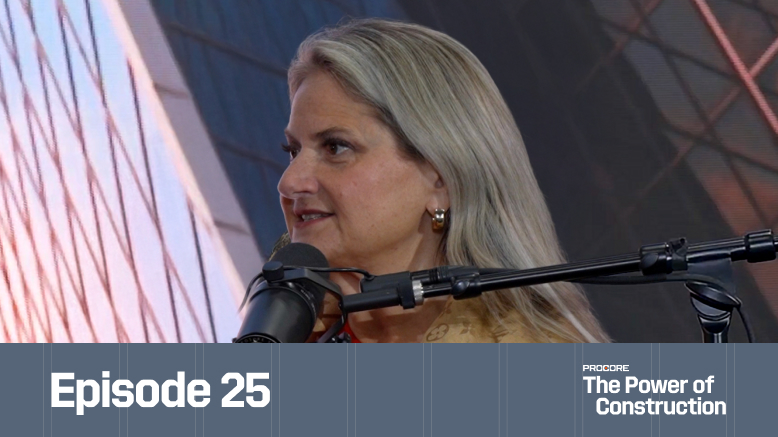— 8 min read
Construction Document Management 101

Last Updated May 6, 2025

Tamara Aspeling
Writer & Construction Estimator
10 articles
Tamara Aspeling is a trained construction estimator and project manager with 25 years of industry experience. She started writing professionally in 2008 and has since written extensively for the construction industry, including publications like Modular Advantage magazine. She is also a traditionally published nonfiction author and the owner of The Construction Writer Inc. Tamara studied at Western Province Technical College in South Africa and completed her national certificate in 1999. She also holds an SEO Certification from Google and a Content Marketing Certification from HubSpot.

Ethan Lobo
Document Control Manager
Ethan is a Document Control Manager for Procore. A New Jersey native, Ethan worked as a construction project manager before moving to New Orleans in 2017, where he is a Louisiana Notary Public. An alumnus of the Levelset (a Procore company) Scout Research team, he now uses his sleuthing skills and construction lien expertise to find and analyze construction and property data to help develop new tools and insights.
Last Updated May 6, 2025

Many people think that manpower and machines are the key to successful construction projects. But the truth is, it’s information and communication that really make all the difference.
Construction document management is not a new concept, but for those looking to build a better company, improve processes and increase profits, it’s a big piece of the puzzle. Let’s take a closer look at what good construction document management is and how to improve it.
Table of contents
The Basics of Construction Document Management
Construction projects generate a lot of paperwork. Construction document management systems are designed to make sure teams can respond to new situations quickly and easily and store information properly.
Construction document management processes should make sure a team is always working with the correct revision or version, that documents are always processed and responded to within a reasonable timeframe and that it is easy for anyone on the team to find the information they need when they need it.
Document management starts before the first crew mobilizes to a jobsite and continues well after they've completed the project. Some of the documents teams need to manage could include the following:
- Bid documents, including site visit notes, drawings and addenda
- Internal estimating documents, calculations and proposal documents
- Construction contracts, including standard construction terms if applicable
- Compliance documents, such as Certificates of Insurance, safety credentials, site training logs and licenses for subcontractors
- Hot work permits, confined space entry permits, lock out/tag out documentation and other key docs that may come up in a safety inspection
- Payment documents like lien waivers, preliminary notices, Notices of Commencement, payment applications, etc.
- Issued for tender (IFT) and issued for construction (IFC) drawing sets, including all versions and revisions
- Resource procurement-related documents, invoices, waybills and shipping-related documents
- Supplier and subcontractor bids or quotes, warranties, design information, datasheets and related documents
- Any RFIs (Requests for Information) created at any stage during the project
- Change orders, change order requests and notifications of intent
- Nonconformance reports and responses
- Closeout documentation, completion certificates and warranties
Keeping track of training logs and documentation is especially helpful when a project has a site-specific orientation workers must go through prior to being allowed on site or when a site requires an OSHA 10 or 30 Cert, CPR/Fist Aid for a competent person on each sub’s crew. Documentation of this type can even include things like toolbox talk checklists/signoffs received from crews in the field, incident reports, and more. These can also be handy to have readily available in the event of an OSHA inspection.

Ethan Lobo
Document Control Manager
Procore Technologies
Key Activities in Construction Document Management
Construction document control processes are an evolving part of any organization. As a company grows, changes and encounters new situations, their team will need to add and change processes and procedures. That’s an expected part of document management. But no management system is perfect, and there are some key steps pros can take immediately to improve their systems right away.
Organization and Storage
The first step in good construction document management is to have a system that stores every document and organizes it for easy retrieval.
This could range from traditional methods like filing cabinets and banker’s boxes to document management software, but whichever method is chosen, deciding document filing system will work and then sticking to those conventions is a key step in the process.
Sharing and Collaboration
The next important thing to remember about construction document control is that information is only valuable if it is shared with the right people.
This means that whatever your chosen document storage method is, there must also be system that allows key people to access that information and, very importantly, ensures integrity and continuity.
Sharing information is critical, but whether it’s losing a file or deleting one, unauthorized access can cause significant problems if there are not security measures in place.
Teams must make sure they have processes in place to track who has accessed stored information and that it is returned to the correct location without unauthorized modifications. Implement an access system that only allows authorized people to access important documents.
Document Control
Aside from just managing construction documents, a well-designed construction document control system will also have processes and procedures in place to make sure everyone is always working with the right version.
Version control is particularly important when it comes to construction drawings or ensuring that your project team is working with the correct version of progress billing or specifications.
At the same time, it’s important to maintain a chronological record of every version of every document for comparison and reference purposes.
System Management
Smaller companies that have less complex document management requirements might find that simpler methods like filing hard copies or using generic cloud storage solutions can work. However, as construction companies and their projects grow, they tend to outgrow those types of systems.
Recognizing the need to evolve to a more sophisticated Document Management System (DMS) or Electronic Document Management System (EDMS) can be a game changer.
The Benefits of Proper Document Management
In the construction world, the truth is that if it’s not on paper, it didn’t happen.
The easiest way to complicate nearly anything is not to have a paper trail, and that also means that good document control benefits every part of a construction business. However, there are some specific benefits that are worth mentioning.
Improved Efficiency
Better document management in construction has both direct and indirect impacts on efficiency. The most obvious, of course, is spending less time searching for a specific piece of information. However, ensuring that your team has access to the right documents and versions at all times also reduces delays because of questions, rework and many avoidable errors.
Better Collaboration
A construction document management system that gives every team and department access to up-to-date information makes collaboration faster and easier.
Whether it’s ensuring that field crews are aware of scheduling changes faster or communicating delivery delays to project planners, a reliable flow of information between stakeholders will always have a positive impact.
Reduced Risk
Construction project risks aren’t always external. In fact, the biggest risks most companies face come from human error.
Ensuring that everyone on the project team has easy access to the most recent, accurate and up-to-date information is one of the best ways to mitigate that risk, and good document control is the key.
Enhanced Compliance
The construction world probably has more regulations than most industries simply because there are so many factors involved in any project.
Whether it’s complying with local government permitting and inspection regulations, meeting health and safety standards or just following the latest edition of the building code, there are a lot of boxes to check on every jobsite.
Good construction document management ensures that the project team always has copies of planning documents, inspection reports, machine maintenance records and everything else they need to keep the job moving forward.
Best Practices for Managing Project Documents
While the idea of implementing better construction document management systems is always daunting, the good news is that there’s no need to reinvent the wheel.
Communication and documentation have been the foundation for better construction projects for as long as humans have been building structures, and there are defined best practices, tools and software available to help.
Every company will have unique needs, but some of the most important things to consider when designing a construction document management system include:
Use the right software.
Rather than a patchwork of hard-to-manage spreadsheets and tools, invest in comprehensive construction software that integrates document management and control systems. Cloud-based systems also allow geographically distant teams to collaborate in real-time.
Implement version control.
Every version of every document should have a version number. This way, everyone can track which version is the most up-to-date and create a history and record of previous versions.
Stick to naming and numbering conventions.
Developing a system for numbering for all file types that is standardized and easy to use makes it easier to create new documents and easily find previous ones in a search.
Build a master index.
Creating a master index of files, documents and drawings — combined with other tips like developing and sticking to naming and numbering conventions — makes document retrieval significantly faster and easier.
Don’t forget backups.
Backing up documents, preferably in multiple formats, is key for good document control. If files are stored digitally on a server, consider an automatic, off-site copy — and make sure all hard copies are digitized and stored electronically as well.
Create a robust security system.
Developing a secure access and permissions system for all stored construction documents is essential. Online systems should have granular permissions for different user groups with read-only, write and edit or administrative permission options. Hard copies should be stored securely, with managed access and a check-out and check-in system.
Maintain an archive.
Construction documents don’t cease to be important when the holdback is released. Legal issues can arise years after a project is completed that might require documented evidence, or a team might want to access project data when bidding on similar projects. So, while it’s always good to differentiate between current and completed project files, it’s important to retain both.
Review and revise as necessary.
Any project, business or document management procedure should be ever-evolving. Set up a regular review and revision process to make sure document control systems are keeping pace with business needs.
Courses about construction.
For construction.
Unlock your career potential with our free educational courses on Health & Safety, Data in Construction, and more.
Information Equals Profit
Poor document control is one of the most significant factors in cost overruns, costing the industry billions of dollars a year. This also means that the inverse can be true — simply by improving communication and document management, companies can increase their bottom line.
So, while improving any system can be cost and time-intensive, it’s worth seeing it as an investment in future success and profits. Every step construction companies can take toward implementing better document control will have a positive effect on their finances.
Was this article helpful?
Thank you for your submission.
0%
0%
You voted that this article was . Was this a mistake? If so, change your vote
Scroll less, learn more about construction.
Subscribe to The Blueprint, Procore’s construction newsletter, to get content from industry experts delivered straight to your inbox.
By clicking this button, you agree to our Privacy Notice and Terms of Service.
Thank you!
You’re signed up to receive The Blueprint newsletter from Procore. You can unsubscribe at any time.
Categories:
Written by

Tamara Aspeling
Writer & Construction Estimator
10 articles
Tamara Aspeling is a trained construction estimator and project manager with 25 years of industry experience. She started writing professionally in 2008 and has since written extensively for the construction industry, including publications like Modular Advantage magazine. She is also a traditionally published nonfiction author and the owner of The Construction Writer Inc. Tamara studied at Western Province Technical College in South Africa and completed her national certificate in 1999. She also holds an SEO Certification from Google and a Content Marketing Certification from HubSpot.
View profileReviewed by

Ethan Lobo
Document Control Manager | Procore Technologies
Ethan is a Document Control Manager for Procore. A New Jersey native, Ethan worked as a construction project manager before moving to New Orleans in 2017, where he is a Louisiana Notary Public. An alumnus of the Levelset (a Procore company) Scout Research team, he now uses his sleuthing skills and construction lien expertise to find and analyze construction and property data to help develop new tools and insights.
View profileExplore more helpful resources

Defending Against Financial & Legal Risks on Megaprojects
The construction industry has seen marked growth in megaprojects. Some experts classify any project over $500 million as a megaproject, while others argue that the build needs to be $1...

Unlocking Project Intelligence: Moving from Raw Data to Actionable Insights
The construction industry faces a wide range of challenges, from ongoing labor shortages to frequent cost overruns. But some the biggest hurdles all stem from unpredictability. The general contractors (GCs)...

Who is accountable for innovation in construction?
Everyone says construction needs to innovate—but no one agrees on who’s actually responsible for making it happen. Is it the owner? The builders? The tech vendor? Or is innovation everyone’s...

Integrated Project Delivery in Practice: A Framework for Collaboration
On construction projects, traditional delivery methods put different stakeholders in their own silos. While the design team feeds drawings and specifications to the general contractor (GC), the GC’s expertise in...
Free Tools
Calculators
Use our calculators to estimate the cost of construction materials for your next project.
Templates
Find a template to help you with your construction project tasks.
Material Price Tracker
Get the latest U.S. retail prices and view historical trends for common building materials.
Glossary
Explore key terms and phrases used in the industry.
